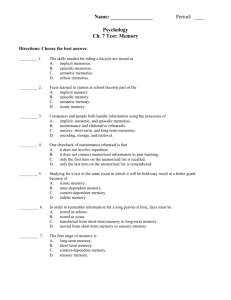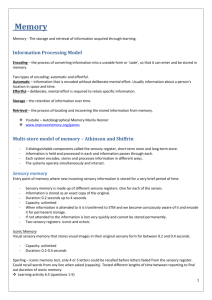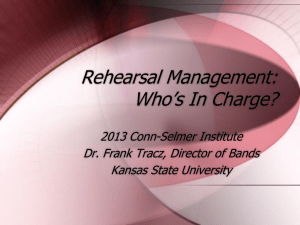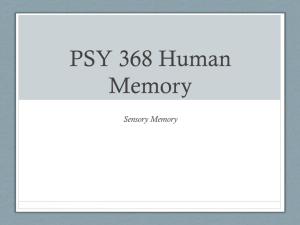Multistore model revision test
advertisement
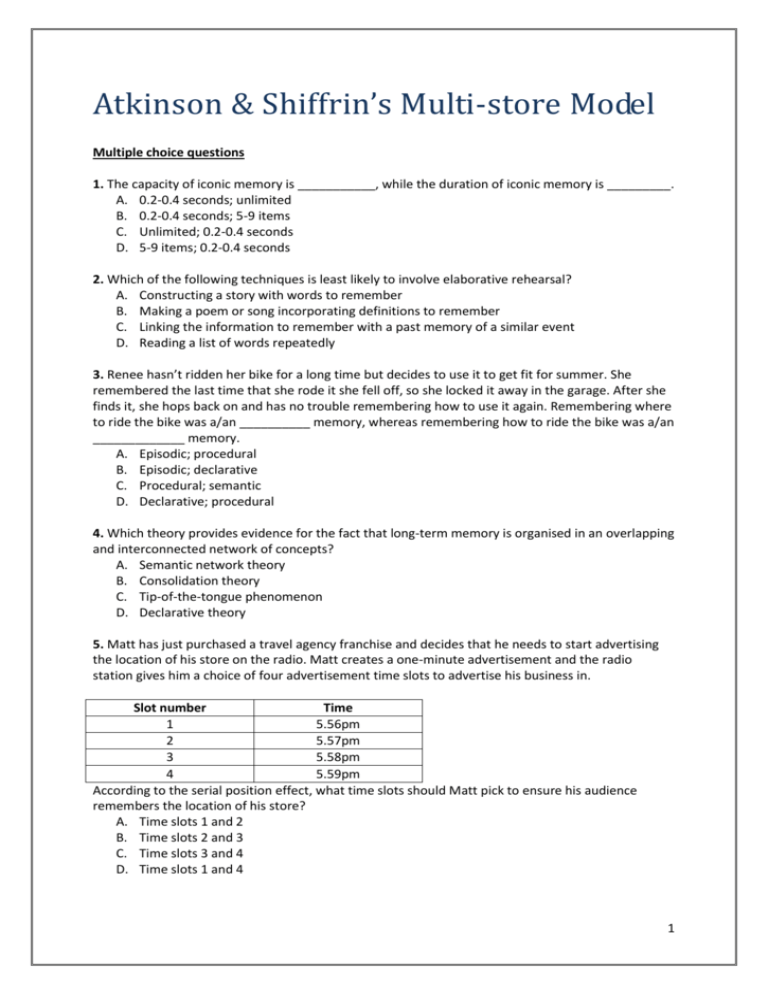
Atkinson & Shiffrin’s Multi-store Model Multiple choice questions 1. The capacity of iconic memory is ___________, while the duration of iconic memory is _________. A. 0.2-0.4 seconds; unlimited B. 0.2-0.4 seconds; 5-9 items C. Unlimited; 0.2-0.4 seconds D. 5-9 items; 0.2-0.4 seconds 2. Which of the following techniques is least likely to involve elaborative rehearsal? A. Constructing a story with words to remember B. Making a poem or song incorporating definitions to remember C. Linking the information to remember with a past memory of a similar event D. Reading a list of words repeatedly 3. Renee hasn’t ridden her bike for a long time but decides to use it to get fit for summer. She remembered the last time that she rode it she fell off, so she locked it away in the garage. After she finds it, she hops back on and has no trouble remembering how to use it again. Remembering where to ride the bike was a/an __________ memory, whereas remembering how to ride the bike was a/an _____________ memory. A. Episodic; procedural B. Episodic; declarative C. Procedural; semantic D. Declarative; procedural 4. Which theory provides evidence for the fact that long-term memory is organised in an overlapping and interconnected network of concepts? A. Semantic network theory B. Consolidation theory C. Tip-of-the-tongue phenomenon D. Declarative theory 5. Matt has just purchased a travel agency franchise and decides that he needs to start advertising the location of his store on the radio. Matt creates a one-minute advertisement and the radio station gives him a choice of four advertisement time slots to advertise his business in. Slot number Time 1 5.56pm 2 5.57pm 3 5.58pm 4 5.59pm According to the serial position effect, what time slots should Matt pick to ensure his audience remembers the location of his store? A. Time slots 1 and 2 B. Time slots 2 and 3 C. Time slots 3 and 4 D. Time slots 1 and 4 1 6. In terms of the serial position effect, findings on delayed recall suggest that: A. Items in the middle of the list produce the most superior recall B. Items at the start and end of the list produce the most superior recall C. Items at the start of the list produce the most superior recall D. Items at the end of the list produce the most superior recall 7. Which memory store is the entry point for incoming sensory information? A. Sensory memory B. Working memory C. Long-term memory D. Short-term memory 8. In terms of the features of our memory systems, the term ‘capacity’ refers to: A. How much information we can remember B. The sort of information we can remember C. How long we can remember information D. How quickly we forget information 9. Information regarding autobiographical events is stored in _________ memory, which is a branch of ___________ memory. A. Declarative; semantic B. Semantic; declarative C. Episodic; declarative D. Episodic; semantic 10. For information to be transferred from sensory memory to short-term memory it must be: A. Attended to B. Encoded C. Rehearsed D. Retrieved 11. People that can retain a visual image in their sensory memory for 30 seconds or longer are thought to have: A. A perfect memory B. An iconic memory C. An echoic memory D. An eidetic memory 12. Which of the following statements regarding types of rehearsal is not accurate? A. Maintenance rehearsal is a more active process than elaborative rehearsal B. Elaborative rehearsal ensures information is more likely to be encoded than maintenance rehearsal C. Information learned using maintenance rehearsal is less likely to be retained in long-term memory than information learned using elaborative rehearsal D. Information is more likely to be linked to existing memories when using elaborative rehearsal 2 13. The superior recall for words at the start and end of a list is known as: A. The serial position effect B. The recency effect C. The semantic network effect D. The primacy effect 14. Which of the following statements regarding semantic network theory is false? A. Each concept that is remembered is referred to as a node B. The longer the link between nodes, the stronger the connection is C. Activation of one node often stimulates related nodes D. The more links that are activated, the quicker the retrieval of information Short answer questions 1. Define the term ‘memory’. __________________________________________________________________________________ __________________________________________________________________________________ 1 mark 2a) Connor has just introduced himself to the new girl at school and she recited her mobile phone number for him. Connor tries to remember the number while he searches for a pen to write it down, but he forgets the last two digits. Explain why Connor is having difficulties remembering the 10-digit mobile phone number. __________________________________________________________________________________ __________________________________________________________________________________ __________________________________________________________________________________ __________________________________________________________________________________ b) Name and explain two techniques that Connor could use to enable him to more effectively remember mobile phone numbers in the future. __________________________________________________________________________________ __________________________________________________________________________________ __________________________________________________________________________________ __________________________________________________________________________________ __________________________________________________________________________________ __________________________________________________________________________________ 1 + 2 = 3 marks 3 3a) What is one difference between iconic and echoic memory? __________________________________________________________________________________ __________________________________________________________________________________ __________________________________________________________________________________ b) What is one similarity between iconic and echoic memory? __________________________________________________________________________________ __________________________________________________________________________________ 1 + 1 = 2 marks 4a) What is short-term memory? __________________________________________________________________________________ __________________________________________________________________________________ b) Name and explain one way that duration of short-term memory can be increased. Name: __________________________________________________________________________________ Explanation: __________________________________________________________________________________ __________________________________________________________________________________ 1 + 2 = 3 marks 5. Name and explain one technique for enhancing the capacity of short-term memory. Use an example to help illustrate how this technique works. Name: __________________________________________________________________________________ Explanation: __________________________________________________________________________________ __________________________________________________________________________________ Example: __________________________________________________________________________________ __________________________________________________________________________________ __________________________________________________________________________________ 3 marks 4 6. What is one difference and one similarity between sensory memory and long-term memory? Difference: __________________________________________________________________________________ __________________________________________________________________________________ Similarity: __________________________________________________________________________________ __________________________________________________________________________________ 2 marks 7. Explain what sort of memories are stored in semantic memory and provide one example. __________________________________________________________________________________ __________________________________________________________________________________ __________________________________________________________________________________ 2 marks 5 Solutions Multiple choice questions 1. C 8. A 2. D 9. C 3. A 10. A 4. A 11. D 5. D 12. A 6. C 13. A 7. A 14. B Short answer questions 1. Memory is an active information processing system where information is encoded, stored and recovered. 2a) The capacity of short-term memory is only 5–9 items and, because the mobile phone number has more digits than this, the information is difficult to retain in short-term memory. b) Chunking – Connor could place the individual numbers to be remember into groups so that there are chunks of information to remember rather than lots of individual pieces. Elaborative rehearsal – Connor could search for number patterns in the phone number to add meaning to the information to be remembered. 3a) Iconic memory receives visual information, while echoic memory receives auditory information. OR The duration of iconic memory is approximately 0.2–0.4 seconds whereas echoic memory lasts for 3–4 seconds. b) Both iconic memory and echoic memory have an unlimited capacity. 4a) A temporary memory store that can hold a limited amount of information while it is in conscious awareness. b)Name: Maintenance rehearsal. Explanation: Rote repetition of information to maintain it in shortterm memory. 5. Name: Chunking. Explanation: Chunking involves grouping individual items into larger units or chunks. Example: Instead of remembering a mobile phone number as 0412345678, chunking involves grouping it such as 0412 345 678. 6. Difference: Long-term memory has a relatively permanent duration whereas information only stays in sensory memory for up to four seconds. Similarity: Both sensory memory and long-term memory can store an unlimited amount of information (unlimited capacity). 7. Semantic memories store information about knowledge and facts. Examples of semantic memories are capital cities and mathematical formulas. 6

